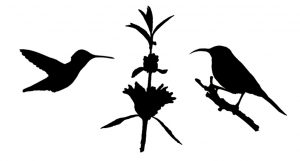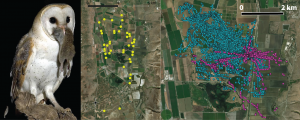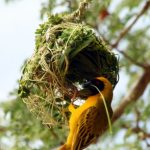Current research foci in the lab are centered on:
- Assembly of Africa’s bird fauna
- Convergent evolution
- Microbiomes and their role in disease transmission and metabolism
- Adaptive landscapes – patterns and processes
- Conservation genetics
(1) Assembly of Africa’s Bird Fauna
With ~11,000 species, birds present the opportunity to study one of the most intriguing global radiations. Avian diversity includes an astonishing wealth of morphological, physiological, behavioral, and ecological variation. It is, therefore, not surprising that birds serve as a prominent model system for comparative study across the disciplines of ecology, evolution, biogeography and global change biology. Important data gaps remain that are highly biased across geographic, environmental, and ecological variables, making generalization difficult and presenting challenges to the notion of truly universal outcomes across bird species. Because phylogenetic relationships among African birds are understudied relative to their counterparts across the globe, one of our major research objectives is to better understand the origin and underlying patterns of diversification in the African avifauna. Toward this end, we adopt a hierarchical approach that combines fieldwork with higher-level systematics, genomic and phylogeographic approaches.
 (2) Convergent evolution of sunbirds and hummingbirds
(2) Convergent evolution of sunbirds and hummingbirds
A powerful way to study mechanisms that generate biodiversity is to focus on instances of convergent evolution, a process through which the same trait evolves independently two or more times, thus providing natural replicates of adaptive evolution. For example, feeding on nectar and its accompanying morphological adaptations (e.g., long tapered bills with specialized tongue structures) have evolved independently in several bird families. We are studying hummingbirds and sunbirds to better understand the ecological and genetic factors that lead to convergent evolution in associated genes and physiology. Our focus extends from investigating convergent evolution in the ability to taste sugar (with Dr. Maude Baldwin), metabolize alcohol (with Dr. Robert Dudley), and live at high elevations characterized by less oxygen (with Drs. Robert Dudley & Jim McGuire). We seek to reveal how often the same genetic changes are responsible for the evolution of functionally similar physiological traits. This research aims to improve scientific understanding of adaptation and species diversification following (i) shifts to a new diet, and (ii) the colonization of high-altitude environments. We are using genomic methods to develop comprehensive evolutionary trees for hummingbirds, sunbirds, spiderhunters, and flowerpeckers, all of which will serve as important resources for revising taxonomy as well as for the conservation of diverse radiations of these birds that together constitute ~5% of global bird species diversity.
 (3) Microbiomes and their role in disease transmission and metabolism
(3) Microbiomes and their role in disease transmission and metabolism
It is broadly accepted that an individual’s life-history traits are shaped both by the alleles inherited from their parents and by the environment in which the individual is raised. Emerging data suggests that the microbiota – the bacteria associated with an individual both internally and externally – may play as significant a role as genetics and the environment in determining fitness. While we know that transmission of microbial lineages can occur either horizontally (host:environment) or vertically (host:parent), the relative importance of each of these pathways is not thoroughly understood in most cases. Through NSF-funded projects, we seek to better characterize the avian microbiome and to leverage these data to develop a clearer understanding of: (1) how migration impacts the evolutionary ecology of hosts and pathogens within migratory host populations and within multispecies host communities that reside in an area used ephemerally by several migratory populations along the Palearctic-Africa Flyway; (2) the extent to which the host microbiome tracks genotype across hybrid zones; and (3) the role of the gut microbiome in facilitating the metabolism of nectar feeding birds and insects.
(4) Adaptive Landscapes – Patterns and Processes
 Mountains: Geographers and biologists have long argued that large-scale environmental factors play a critical role in driving patterns of speciation and extinction. Of particular interest are mountains, where climate interacts with topographic relief to generate sharp local habitat gradients. This process may allow complex communities and species to persist locally by promoting population isolation and speciation, as well as by facilitating the long-term persistence of the relictual lineages characteristic of tropical biodiversity hotspots. Work in our lab, as well as in several other laboratories around the world, has revealed that montane habitats have experienced a complex pattern of fragmentation through Quaternary climate-cycles, ranging from periodic connectivity between close neighbors to long-term isolation of remote mountains. While we may expect some topological congruence in area cladograms among lineages, suggesting a common spatial history, the timing of such processes may vary. Using a combination of extensive fieldwork, genomics, morphometrics, and species distribution modeling, we are exploring this timing and related questions about community assembly and adaptation across elevational gradients in the montane habitats of Africa, Central America, and western North America as well as, most recently, on Wallace’s anomalous island of Sulawesi, Indonesia.
Mountains: Geographers and biologists have long argued that large-scale environmental factors play a critical role in driving patterns of speciation and extinction. Of particular interest are mountains, where climate interacts with topographic relief to generate sharp local habitat gradients. This process may allow complex communities and species to persist locally by promoting population isolation and speciation, as well as by facilitating the long-term persistence of the relictual lineages characteristic of tropical biodiversity hotspots. Work in our lab, as well as in several other laboratories around the world, has revealed that montane habitats have experienced a complex pattern of fragmentation through Quaternary climate-cycles, ranging from periodic connectivity between close neighbors to long-term isolation of remote mountains. While we may expect some topological congruence in area cladograms among lineages, suggesting a common spatial history, the timing of such processes may vary. Using a combination of extensive fieldwork, genomics, morphometrics, and species distribution modeling, we are exploring this timing and related questions about community assembly and adaptation across elevational gradients in the montane habitats of Africa, Central America, and western North America as well as, most recently, on Wallace’s anomalous island of Sulawesi, Indonesia.
 Western North America: The western United States, with its many young vertebrate species and contact zones, offers an ideal system for studying the evolutionary forces that lead to speciation. Despite general agreement that much phenotypic and genetic diversity was initiated by periods spent in allopatry, there is currently no comprehensive framework that accounts for the mechanisms underlying diversification of North American vertebrates. There is evidence of allopatry in the present distribution patterns of several species and complexes of North American birds and small mammals with distinct Pacific-slope, Rocky Mountain, and Eastern forms. Many of these taxa meet in secondary contact and, in most such cases, hybridization occurs. Our lab combines the use of genomic, morphological, bioacoustic, and climate modeling analyses, as well as song playback experiments in birds, to characterize zones of admixture, and to test for the effect of divergent social signals on reproductive isolation. Because bird song can function as a cue for assortative mating, playback experiments can act as experimental tests of the level of reproductive isolation between taxa; the results of these experiments, combined with genomic data, allow us to measure both pre- and post-zygotic isolation. Our work focuses on birds and small mammal species (gophers and voles) with particular emphasis on: (1) characterization of hybrid zones in California; (2) changes in allele frequencies over time and the relative importance of drift and selection as explanatory variables; and (3) diversification of birds across the Channel Islands of southern California.
Western North America: The western United States, with its many young vertebrate species and contact zones, offers an ideal system for studying the evolutionary forces that lead to speciation. Despite general agreement that much phenotypic and genetic diversity was initiated by periods spent in allopatry, there is currently no comprehensive framework that accounts for the mechanisms underlying diversification of North American vertebrates. There is evidence of allopatry in the present distribution patterns of several species and complexes of North American birds and small mammals with distinct Pacific-slope, Rocky Mountain, and Eastern forms. Many of these taxa meet in secondary contact and, in most such cases, hybridization occurs. Our lab combines the use of genomic, morphological, bioacoustic, and climate modeling analyses, as well as song playback experiments in birds, to characterize zones of admixture, and to test for the effect of divergent social signals on reproductive isolation. Because bird song can function as a cue for assortative mating, playback experiments can act as experimental tests of the level of reproductive isolation between taxa; the results of these experiments, combined with genomic data, allow us to measure both pre- and post-zygotic isolation. Our work focuses on birds and small mammal species (gophers and voles) with particular emphasis on: (1) characterization of hybrid zones in California; (2) changes in allele frequencies over time and the relative importance of drift and selection as explanatory variables; and (3) diversification of birds across the Channel Islands of southern California.
 Southern Africa: Arid zones cover one third of the Earth’s land surface, and many have levels of local endemism as high as those of tropical biomes. Despite supporting a rich biodiversity, arid ecosystems are generally overlooked as model systems for investigating evolutionary processes that may have led to high levels of diversity. Characterized by a high interior plateau bounded on three sides by a steep escarpment and the presence of a west-to-east gradient of increasing moisture, Southern Africa provides an ideal spectrum of hyper-arid to humid habitats for such studies. Its complex topography and climatic variation is reflected at the landscape level by multiple biomes–Succulent Karoo; Nama Karoo; Fynbos; Grassland; Savanna; Albany Thicket; and Montane Forest–several of which are globally recognized as hotspots of biodiversity. Over the past decade, we have sought to understand the processes that drive the diversification and high local endemism of species and species-assemblages across southern African. Our focus has been on investigating phylogeographic patterns and process across co-distributed species, testing for congruence between evolutionary and demographic histories and determining how species or suites of species have interacted with particular geographical and/or ecological features of the region across their evolutionary history. Members of our lab have worked on a variety of species and species assemblages including: birds; butterflies; beetles; midges; fish; and molluscs.
Southern Africa: Arid zones cover one third of the Earth’s land surface, and many have levels of local endemism as high as those of tropical biomes. Despite supporting a rich biodiversity, arid ecosystems are generally overlooked as model systems for investigating evolutionary processes that may have led to high levels of diversity. Characterized by a high interior plateau bounded on three sides by a steep escarpment and the presence of a west-to-east gradient of increasing moisture, Southern Africa provides an ideal spectrum of hyper-arid to humid habitats for such studies. Its complex topography and climatic variation is reflected at the landscape level by multiple biomes–Succulent Karoo; Nama Karoo; Fynbos; Grassland; Savanna; Albany Thicket; and Montane Forest–several of which are globally recognized as hotspots of biodiversity. Over the past decade, we have sought to understand the processes that drive the diversification and high local endemism of species and species-assemblages across southern African. Our focus has been on investigating phylogeographic patterns and process across co-distributed species, testing for congruence between evolutionary and demographic histories and determining how species or suites of species have interacted with particular geographical and/or ecological features of the region across their evolutionary history. Members of our lab have worked on a variety of species and species assemblages including: birds; butterflies; beetles; midges; fish; and molluscs.
 (5) Conservation Genetics
(5) Conservation Genetics
Analyses using molecular markers spread across the genome have for many decades played an important role in conservation biology and management. Our lab works to leverage these tools to further conservation-related goals by: 1) characterizing genetic diversity within and among populations, 2) resolving taxonomic uncertainties, particularly where range-restricted species are apparent, and 3) combining molecular data with other datasets to describe new taxa and clarify the distributional boundaries of other taxa. Current projects focus on Spotted and Barred Owls, Californian Condors, and isolated populations of Horned Larks in western North America, along with several African bird and insect species. If you are interested in collaborating on a species of conservation concern, please contact us.